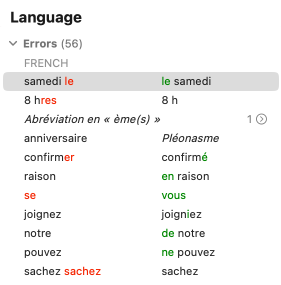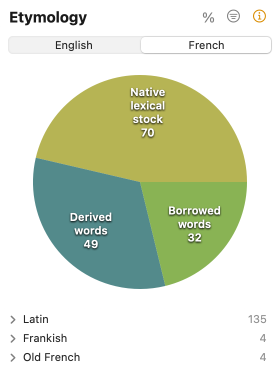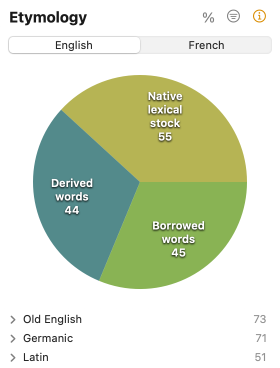The French Corrector
Working in conjunction with its English counterpart, Antidote’s French corrector is a powerful and sophisticated tool that analyzes the linguistic, stylistic and typographical characteristics of your text—whether it is written exclusively in French or includes passages in both languages.

Antidote’s French corrector covers a wide range of language issues. It can detect and correct errors involving spelling, hyphens and capitalization; errors of grammatical agreement, including the notoriously difficult past participle; homophones (différent/différend, ces/ses, voir/voire, etc.) and other frequently confused words; the correct way to write dates, numbers or addresses in French; repetitions; inconsistent spelling; punctuation and spaces before punctuation marks; etc.
- Click Antidote’s Help menu and select Useful documents. In the folder that opens, you will find a folder titled Évaluation-fr. Open the rich text document inside titled Démonstration de correction to see the range of corrections that Antidote can make in French.
Two standards for French orthography have coexisted ever since far-reaching reforms were proposed for French spelling by the Conseil supérieur de la langue française in 1990. The two conventions are called graphie traditionnelle and graphie rectifiée. Antidote can automatically correct your spelling to meet either of these two standards—the choice is yours. It can even flag inconsistent spellings of the same word in a text.
To help polish your prose, Antidote’s Style view highlights critical style questions for the French language through its five filters. They look for repetitions, long sentences, verbless sentences, various potentially awkward constructions, semantic redundancies, commonplace verbs, rare or long words, and many more. The Style view also highlights passages in which more equal representation of men and women is possible.
In addition, the French corrector includes various linguistic filters that let you examine your text from several angles. The filters in the Revision prism focus on certain pragmatic, logical and semantic aspects of the text. The Inspection prism lays bare the sentence’s constituent elements: syntactic categories and functions, verb tenses, etc. The Statistics prism compiles statistics on the text’s various linguistic parameters and illustrates them graphically: the various error types, the most frequent words, the distribution of words according to their etymology, etc.
Bilingual texts
A text written largely in French may also include passages in English and vice versa. These can consist of quotes, titles of books, etc. Antidote automatically identifies a text’s predominant language and flags passages in the other language with a vertical blue bar in the left margin. If the automatic language detection does not produce the expected result, you can manually specify the language of a particular passage or of the entire document by right-clicking the text in question and selecting Language of the Selection or Language of the Document. These options are also available from the Antidote’s Corrector menu.
Statistical information on the distribution of the two languages is displayed in the status bar at the bottom of the correction panel (e.g. 58% French / 42% English).
Important: the number and type of errors flagged by Antidote’s French corrector depend on your settings, including those defined under First language and Written French ability. Various other settings are found in both the English and the French versions; see the Settings section in this chapter for more details.
The list of detections

The list of detections is divided by language: under each class of detection, the headings ENGLISH and FRENCH appear to clearly distinguish between the detections generated for each language.
Separate filters for each language
Certain filters feature two buttons, English and French, for multilingual texts. Clicking them lets you switch between the analyses of the French and English passages. The filters that display these buttons are: (in the Statistics prism) Error Types, Etymology and Categories; (in the Inspection prism) Categories, Phrases, Syntactic Functions and Conjugation.


Using the corrector
In most respects, the French corrector is similar to the English corrector described in the Corrector chapter. Please refer to those pages for details on how corrector operates similarly in both languages: the ways users can access the corrector, the meaning of the different types of underlining, explanations of the different types of detections, the various settings, etc. This section describes features that are unique to Antidote’s handling of French texts.
Language-specific features of the Style view

The options for the Style view apply to both languages, except when the language is specifically mentioned below the option.
The sections within the Style view adapt to the particularities of each language. For example, split infinitives are irrelevant to French, and so the Constructions section of the French Style view does not detect them. However, it does include a number of detections specific to French, such as participial phrases and the formation of negatives. Similarly, in the Vocabulary section, the French Module distinguishes between offensive (e.g. racist, insulting, sexist, etc.) and inappropriate vocabulary (e.g. sexual, scatological, violent), while it does not detect contractions or nominalizations. Similarly, the Gender neutrality section produces different detections in French compared to its English counterpart, reflecting the different concerns specific to each language.
Language-specific features of the Inspection and Statistics prisms
The National varieties filter that appears in the Inspection prism of the English Module does not exist in the French Module. However, the French Module does include three filters that don’t apply to English but are very relevant to French grammar: Agreement, which is far more complex in French, (grammatical) Genders and Spelling rectifications. The Syntactic functions and Conjugation filters also differ with the French Module, owing to the differences between French and English grammars. You will also notice changes in the Etymology filter’s results (Statistics prism), since far more words in French derive from Latin, Gaulish and Frankish origins.
Note — Learn more about the Inspection and Statistics prisms.
Detailed analysis

As in the English Module, Antidote produces a detailed analysis for French sentences, with the difference that it employs certain notions that pertain to French grammar (e.g.: épithète, genre, incise). For a clear definition of these terms, you can consult Antidote’s dictionaries.